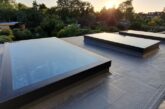
Paul Higgins, Commercial Director at TuffX, looks closer at the diverse glazing solutions available for modern extensions
A glazing first approach
Whether you’re working on a single-storey extension, a double-height transformation, or a smaller side return, one key design element that can elevate any extension project is glazing. The right glazing choices make all the difference, boosting natural light, supporting thermal performance, and enhancing visual appeal.
Popular options include rooflights and skylights for overhead illumination, roof lanterns as dramatic focal points, and bi-fold doors or floor-to-ceiling windows that seamlessly connect indoor and outdoor spaces. Glass balustrades ensure seamless light penetration from every angle, and even infill panels within solid tiled roofs provide a smart way to introduce daylight into otherwise enclosed areas. Collectively, these solutions can significantly enhance the look, feel, and efficiency of any extension.

Bespoke sizing and quality control
When looking to add value and versatility to projects, offering bespoke rooflight sizes can be a real game-changer. It provides more than just standard sizing options; it opens up creative design possibilities that standard options can’t match and creates a competitive advantage for homeowners seeking a more premium, high-spec finish. Just a few centimetres can make all the difference.
All Tuffx products are proudly ‘Made in Britain’, and the brand proudly carries the official trademark for British manufacturing. This ensures quality and capability for a quick turnaround on bespoke rooflight orders, allowing the build to progress as planned without any delays.
When it comes to frame specification, it is just as crucial as the glazing itself. Insulating frames are engineered to work in tandem with the glass, preventing heat loss in colder months and limiting heat gain during warmer periods, ensuring year-round comfort.

Creating comfortable indoor environments
Managing thermal performance is especially important in large, glazed areas where the risk of overheating can be a concern. High-quality solar glass products play a crucial role in achieving the comfortable ambient interior temperature that occupants desire, without relying on air cooling technologies.
With solar control glass, the amount of solar energy entering a building is controlled using a tinted coating on the outside of the glass. In short, solar glass products can reflect heat away from the inside of the home to help ensure the space doesn’t get overheated. Solar glass is also a much more cost-effective solution to the problem than specifying air cooling technologies, and it’s possible to specify solar glass, which is designed to reflect twice as much heat as standard glass.

Heating and glazing combined
Eliminating the need for wall-mounted heat emitters in an extension, particularly in compact spaces, can significantly transform the room’s design and usability. GLOW heated glass provides a double-duty solution in bi-fold doors and roof infill panels, thanks to an invisible conductive coating that is electrically heated to convert electric power into radiant heat.
Ensuring it can be relied upon as the primary heat source, the glass surface temperatures reach 35-40°C and are controlled via a wall-mounted thermostat, freeing up wall space where traditional radiators need to be placed and enhancing interior layout opportunities.
This radiant heat technology has an average hourly cost of around 9p per bi-fold door, so, for example, a three-door bi-fold configuration running for five hours per day will cost around £1.35 (based on an electricity cost of 25p/kWh). Glow installation costs are lower than electric underfloor heating or traditional radiators, making it a more budget-friendly option.
Heated glass also dramatically reduces condensation, preserving uninterrupted views both upwards through the roof space and outwards to the garden. Plus, unlike regular traditional emitters, no ongoing maintenance is required, providing a hassle-free heating solution for extensions.
Low-carbon solutions
For customers seeking solutions to reduce the carbon impact of their extensions, low-carbon glass can enhance the overall energy performance of homes.
This specialist glass, produced with lower energy consumption and fewer carbon-intensive materials, contributes to a building’s overall embedded carbon, from construction to operation. The raw materials required to create low-carbon glass are also sourced sustainably, further reducing the environmental impact of production.
This innovative glass offers superior insulation properties, preventing heat loss in winter and reducing the need for air conditioning in summer, which further cuts energy use. Designed to withstand the test of time, low-carbon glass decreases the frequency of replacement, regardless of external factors like weather, temperature fluctuations, or normal wear and tear. Consequently, this superior-quality solution boasts a longer lifecycle, lessening the need for maintenance tasks such as cleaning and repairs and the environmental burden of replacement.
Tuffx was the first manufacturer in the world to introduce low-carbon glass, which was expertly designed without compromising quality and performance. Offering the same aesthetics as regular clear glass, the products contain 64% recycled content and are produced using renewable electricity throughout the manufacturing process.
For further information about TuffX, visit tuffxglass.co.uk.








